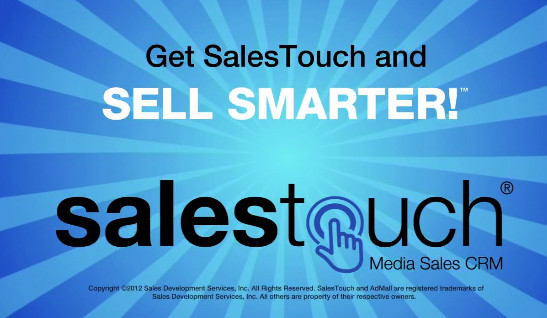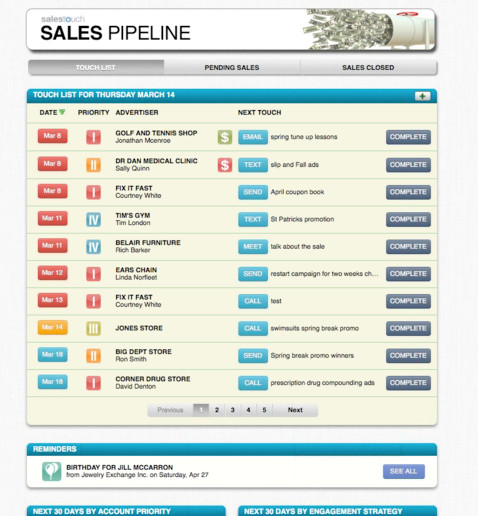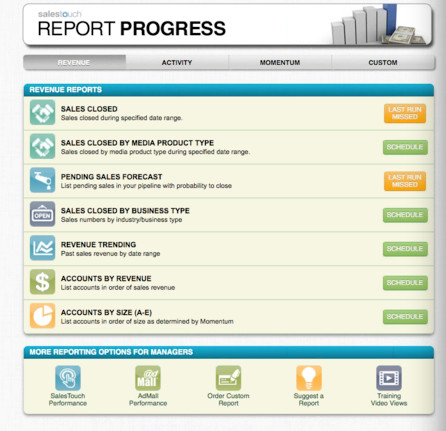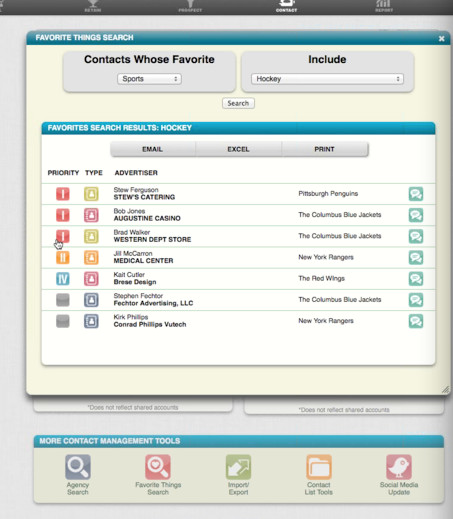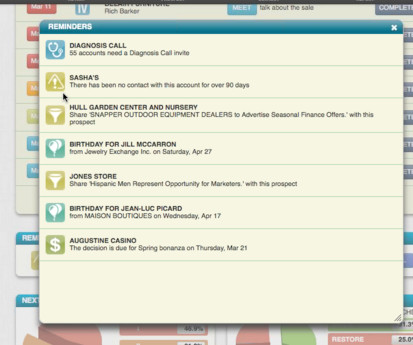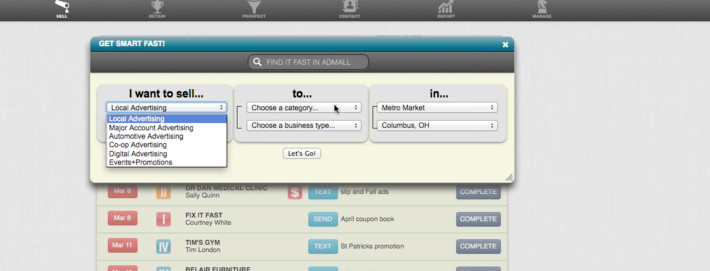OPUBCO gains six figure increases SalesTouch CRM
SalesTouch from Admall uses rolling financial data to prioritize daily call lists
Media: The Oklahoman
Owner: OPUBCO Communications (Anshutz)
Key executive: Patti Hannan, VP of Sales and Marketing, OPUBCO Communications; Barry Shawgo, VP of Sales Development, Sales Development Services (SDS)
Intitiative: Implementation of SalesTouch CRM
Summary: OPUBCO has implemented a new CRM that has resulted in six figure revenue growth and gained support of the sales staff. The CRM, SalesTouch, designed specifically for local media companies, helps sellers prioritize accounts based on spending history.
Challenge: Sales managers at OPUBCO were challenged to help reps organize their time more productively and to focus critical selling time on the highest potential value accounts.
“Salespeople have a natural inclination to spend time on accounts that are on autopilot; even though those are the accounts that need less daily attention,” said Patti Hannan, vice president of sales and marketing for OPUBCO. She wanted to find a CRM system that would help reps focus on accounts with higher spending potential.
Strategy
1. Selecting the CRM system
Hannan deployed SalesTouch, a CRM system that incorporates data on advertisers’ spending history to predict which accounts are using other media, and which have the potential to spend more money. SalesTouch then provides a prioritized daily list of action items for reps.
Jerry Kackley, a consultant at K Group and a SalesTouch partner, created the spending algorithm used in SalesTouch. His studies on numerous sales teams across the country found that only 22% of sales time is spent on accounts at risk of decline or those with the highest growth potential. His algorithm uses data from 24 months of spending history to identify and prioritize accounts into one of four engagement segments: Grow, Restore, Reset, or Maintain. It then assigns a priority level indicating the importance of the account to the sales rep.
SalesTouch also has a mobile component, which allows reps to access their accounts in their territories via smartphone or tablet, communicate with clients via social media, create proposals, and other useful tools such as pop-up explanations and reminders, and even the ability to show client's favorite perks, so that priority accounts get trade tickets and other spiffs first.
The core of the system, however, is the algorythm that helps reps know exatly what to do every day to maximize sales, which has had a transformative impact on the efficiency of the department.
2. Getting started
When OPUBCO implemented SalesTouch in July 2012, the first step was uploading and analyzing two years of revenue data. Every three months a rolling account history is uploaded for each rep.
“We weren’t paying attention to revenue history,” Hannan said. “If we had looked at the history before, we could have predicted which accounts we were slowly losing.”
From start to launch took about six weeks.
3. Training on new concepts
Sales reps using SalesTouch are trained to understand new concepts such as Momentum, relative spending, account segmentation, and priority levels. They have also learned how to engage differently with accounts, based on whether they’re flat, growing, or in decline. SalesTouch actually builds the daily “to-do list” for reps, including everything that needs to be accomplished for priority accounts. On-screen prompts reinforce key concepts to help reps master the system.
Four levels of momentum
The Momentum classification is a key rating assigned to each account based on spending history:
•Restore. These are accounts that have started to decline. “When a best client tells you that they are ‘going dark’ for a week, you can take an educated guess that they are advertising elsewhere,” said Barry Shawgo, vice president of sales for SDS.
Shawgo says that negative momentum affects 20-28% of local media accounts at any given time; and that catching and addressing these accounts early is key to preserving the revenue share of the account. The Diagnosis Call, a client needs-analysis system built into SalesTouch, uncovers additional advertising and revenue opportunities with each client.
•Grow. These are accounts that are increasing their ad spending, and have the highest growth potential. Sales reps should be calling on these accounts more frequently to suggest additional campaign ideas.
•Maintain. These accounts maintain a consistent level of spending, generally have the least potential for increased revenue, and are typically ones where reps spend the most time. Although they need to be maintained, these accounts should not be the highest priority for a rep.
•Reset. These are accounts that have already been lost. Reps spend a great deal of time trying to win these advertisers back, but these accounts often need different strategies which may include management involvement to help turn them around.
Relative spending
Reps can also see how much their accounts are spending relative to other advertisers in the same category, at that media. For example, if a jewelry account is up 8%, it could still be relatively flat, compared to all of the other jewelry accounts that are spending with OPUBCO.
“The fact that a company is under-spending, compared to the category average, is a detail that’s good to know,” said Hannan.
Four levels of priorities
Accounts are also assigned a priority level of 1 to 4, based on Momentum level, size, seasonality, and other spending in that category. Reps organize their time using a daily pipeline of action items for priority accounts; so that most of their time is spent with accounts that have the most potential for growth (see second slide above and click to enlarge for an example of what the daily "to do" list looks like).
Hannan says a key advantage of SalesTouch is that the daily priorities list provides a roadmap for sales reps to follow.
“Without this framework, it’s far too easy for accounts to fall through the cracks and get neglected.”
She says the predictive aspect is both "surprisingly good" and adopted easily by sales reps. "What I was suprised by when it rolled out is that (all the reps) completely trust that...these are your priorities: 1,2,3,4."
Also popular are reminders that flag reps to acknowledge client birthdays, prompt the customer at proposal decision due dates, and other key follow-up touches (see images above, and click to enlarge).
A "favorites" field (also above) shows what freebies a customer prefers, such as tickets to one team but not another, along with the priority of the customer so that that managers dispensing script can optimize it's impact.
Mobile optimization allows reps to check accounts via any mobile device - phones, tablets, and minis - and post social communications to acounts.
Pricing
An Admall Pro subscription is a requirement to obtain SalesTouch and runs $225 to $1015 per month depending on number of size-related factors. SalesTouch itself is $79 per seat, which includes set-up, training and support.
Results
• Some accounts labeled 'growth' have had huge gains from implementing plans that were initiated by strategies suggested by the system. They include a dentist under-spending at $8000 a year, that was turned into a $100,000 account.
• Prioritized accounts has significantly altered sales representatives focus away from accounts in maintenance mode to those with growth potential. "It's exactly the opposite of the accounts we were focusing on," Hannan said.
• Sales people like the system and feel they are more organized, efficient and productive. Hannan says it is difficult to convey how transformational the gains in efficiency have been.
• Estimated revenue gains are in the high six figures.
Lessons learned
• A new kind of training is required for accounts that are in the restore or reset mode. "There are things you can do to just warm them up," Hannan says, such as sending them news items and reports on their industry that they may be interested in.
• Using technology, rather than sales person input, to prioritize accounts is working for both managers and for the reps.
• ROI on the system has been exceptional.
Our take
We are seeing more companies using this new system. Other SalesTouch customers include the Southbend Tribune, Reminder Media, The Kansas City Star, Denver Post and WKEF-WRGT-TV.
In the broader media spectrum, however, many local media still do not even have clean email list for prospects, much less a pipeline. This method of prioritization is even more advanced than pipelines and shows the ability of data-mining your own customers. We also like that the system is visually appealing with color-coded priorities and mobile-ready tools. Out of all the media we've interviewed about various vendors, this was the one vendor about whom executives clearly raved the most.

The author, Alisa Cromer is publisher of a variety of online media, including LocalMediaInsider and MediaExecsTech, developed while on a fellowship with the Reynolds Journalism Institute and which has evolved into a leading marketing company for media technology start-ups. In 2017 she founded Worldstir.com, an online magazine, to showcases perspectives from around the world on new topic each month, translated from and to the top five languages in the world.

